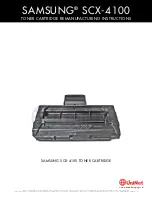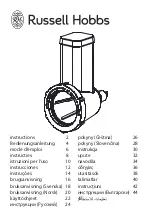
D
–EIMWC00803-21_01EN - 32/57
8.2
Routine Maintenance
8.2.1
Lubrication
Improper servicing of the lubrication system, including the addition of excessive or incorrect oil,
substitute quality oil filter, or any mishandling can damage the equipment. Only authorized and
trained service personnel should attempt this service. For qualified assistance, contact your local
Daikin service location.
After the system is once placed into operation, no other additional oil is required except in the event that repair work
becomes necessary to the oil pump, or unless a large amount of oil is lost from the system due to a leak.
If oil must be added with the system under pressure, use a hand pump with its discharge line connected to the backseat
port of the valve in the lubricant drain from the compressor to the sump. The POE oils used with R-134a, R-513A and R-
1234ze are hygroscopic and care must be exercised to avoid exposure to moisture (air).
The condition of compressor oil can be an indication of the general condition of the refrigerant circuit a nd compressor wear.
An annual oil check by a qualified laboratory is essential for maintaining a high level of maintenance. It is useful to have
an oil analysis at initial startup to provide a benchmark from which to compare future tests. The local Daikin service office
can recommend suitable facilities for performing these tests.
8.2.1.1
Interpreting Oil Analysis Data
Oil wear metals analysis has long been recognized as a useful tool for indicating the internal condition of rotating machiner y
and continues to be a preferred method for Daikin centrifugal chillers. Daikin Service or a number of laboratories
specializing in oil testing can do the test. To accurately estimate the internal condition it is essential to properly interpret
the oil wear test results.
Numerous test results from various testing laboratories have recommended action that has prompted unnecessary concern
by customers. Polyolester oils are excellent solvents and can readily dissolve trace elements and contaminants. Most of
these elements and contaminates eventually end up in the oil. Also, the polyolester oils used in R-134a, R-513A and R-
1234ze chillers are more hygroscopic than mineral oils and can contain much more water in solution. For this reason, it is
imperative that extra care be used when handling polyolester oils to minimize their exposure to ambient air. Extra care
must also be used when sampling to ensure that sample containers are clean, moisture -free leak proof and non-permeable.
Daikin has done extensive testing in conjunction with refrigerant and lubricating oil manufacturers and has established
guidelines to determine action levels and the type of action required.
In general Daikin does not recommend changing lubricating oils and filters on a periodic basis. The need to change
lubricating oil and filters should be based on a careful consideration of oil analysis, vibration analysis and knowledge of the
HFC-R1234ze Temperature Pressure Chart
°F
PSIG
°F
PSIG
°F
PSIG
°F
PSIG
6
3.1
46
26.8
86
69.2
126
138.3
8
4.0
48
28.4
88
71.9
128
142.6
10
4.8
50
30.0
90
74.8
130
147.0
12
5.8
52
31.7
92
77.6
132
151.5
14
6.7
54
33.5
94
80.6
134
156.1
16
7.7
56
35.3
96
83.6
136
160.8
18
8.7
58
37.2
98
86.7
138
165.6
20
9.7
60
39.1
100
89.9
140
170.5
22
10.8
62
41.1
102
93.1
142
175.4
24
11.9
64
43.1
104
96.5
144
180.5
26
13.0
66
45.2
106
99.9
146
185.7
28
14.2
68
47.3
108
103.3
148
191.0
30
15.4
70
49.5
110
106.9
150
196.3
32
16.7
72
51.7
112
110.5
152
201.8
34
18.0
74
54.0
114
114.2
154
207.4
36
19.4
76
56.4
116
118.0
156
213.1
38
20.8
78
58.8
118
121.9
158
219.0
40
22.2
80
61.3
120
125.9
160
224.9
42
23.7
82
63.9
122
129.9
162
230.9
44
25.2
84
66.5
124
134.1
164
237.1
















































